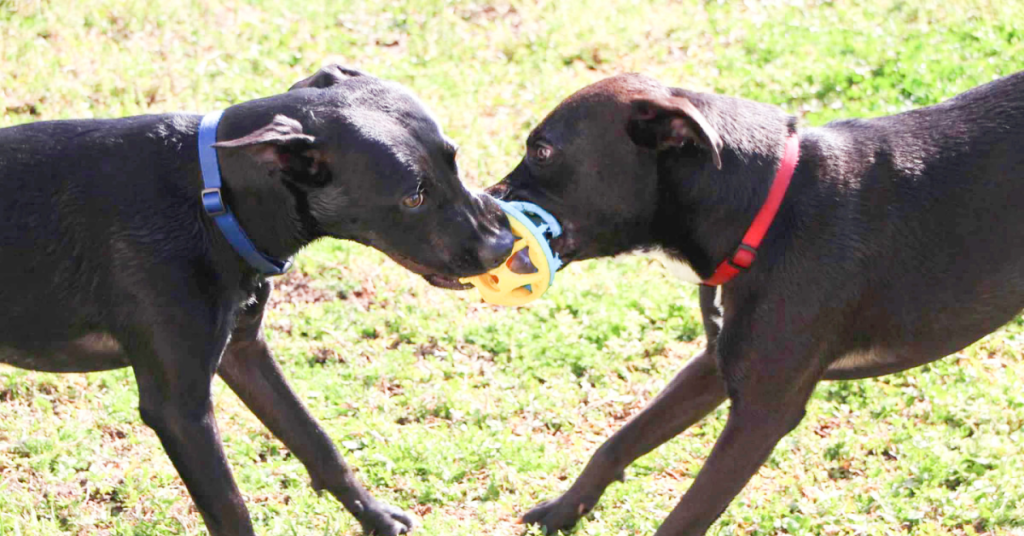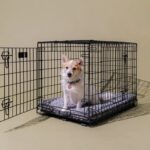Break up a dog fight by staying calm, avoiding direct grabs, and using safe methods like loud noises, water, or barriers to distract the dogs. If distraction fails, use the “wheelbarrow method” by lifting each dog’s back legs and pulling them apart. Never put your hands near their mouths to prevent injury.
Signs of Play vs Real Fighting
During play, dogs display distinct “loose” body language. A classic play bow – chest lowered to the ground with hindquarters raised – signals friendly intentions. Additionally, dogs take turns being dominant, trade roles while wrestling, and maintain open-mouthed expressions without forceful biting.
Conversely, aggressive encounters show markedly different signals. Watch for:
- Stiff body posture with raised hackles
- Intense staring and pinned-back ears
- Deep, threatening growls rather than playful vocalizations
- Repeated lunging toward neck or vital areas
One reliable indicator of play: sneezing. Dogs sneeze deliberately to communicate their intent to keep interactions safe and enjoyable.
The Three Main Fight Categories
Dog fights typically fall into three distinct categories based on severity:
- No to Low-Contact Scuffles: Characterized by loud snarling and barking but minimal physical contact. These fights often resolve through vocal displays alone.
- Bite-Release Conflicts: Dogs attempt bites but release quickly rather than holding on. These encounters require swift intervention as they can rapidly escalate.
- Bite-Hold Fights: The most dangerous category where dogs bite and maintain their grip, sometimes violently shaking their opponent. These fights tend to be quieter since the dogs’ mouths are engaged.
Risk Levels for Each Type
Understanding risk levels helps determine appropriate intervention strategies. Scuffles primarily pose psychological risks rather than physical danger. Nevertheless, they can swiftly escalate if ignored.
Bite-release conflicts carry moderate risk, particularly when involving dogs of different sizes. The primary danger comes from potential puncture wounds and lacerations.
Bite-hold fights present the highest risk level. These encounters frequently result in severe injuries including:
- Deep puncture wounds
- Crushing injuries
- Broken bones
- Significant blood loss
The environment also influences risk levels. Organized fights in confined spaces prevent escape options, whereas spontaneous conflicts in open areas allow dogs to retreat. Furthermore, fights between household dogs require special consideration since they share living space and may harbor ongoing tensions.
Essential Safety Equipment
Preparing a well-equipped safety kit stands as the cornerstone of responsible dog ownership, especially for breaking up potential fights. A properly assembled kit coupled with strategic placement throughout your living space ensures quick access during emergencies.
Building Your Fight Break-Up Kit
First, assemble a comprehensive kit containing essential tools for different scenarios. Start with multiple slip leads – at least two or one per dog in multi-dog households. These leads serve as crucial restraints once dogs separate.
Water-based tools prove effective as initial deterrents. Although garden hoses work outdoors, portable spray bottles offer mobility. Subsequently, use barriers to maintain separation after water successfully startles the dogs.
Physical Intervention Tools:
- Break sticks (specifically designed for releasing bite holds)
- Thick blankets or protective barriers
- Spray Shield™ (formerly Direct Stop)
- Kevlar gloves for hand protection
- CO2 fire extinguisher for emergencies
For maximum effectiveness, choose items from different categories. This approach increases the likelihood that at least one tool will work effectively in various situations. Nonetheless, remember that these tools require proper training and familiarity before use in actual emergencies.
Where to Keep Safety Tools
Strategic placement of safety equipment throughout your environment maximizes quick access during critical moments. Establish designated locations in various areas of your home or facility. For professional settings, maintain written protocols detailing equipment locations and proper usage guidelines.
Indoor Placement:
- Keep kits near common gathering areas
- Position equipment near doors leading to exercise areas
- Store backup supplies in easily accessible storage spaces
- Place emergency whistles in multiple rooms
Outdoor Considerations:
- Mount water hoses at strategic points
- Store portable kits near exercise yards
- Position air horns near outdoor play areas
- Keep spare leads near entry/exit points
Safe Distance Techniques
Distance-based intervention methods offer the safest approach for stopping dog fights without risking personal injury. Understanding these techniques empowers dog owners to handle confrontations effectively while maintaining a safe distance from the conflict.
Using Water and Sound
Water serves as an immediate deterrent for most fighting dogs. A garden hose directed at the dogs’ faces often startles them enough to break their focus. Still, this method might prove ineffective with highly aggressive or working dogs.
Sound-based interventions present another viable option. Ultrasonic pet trainer devices generate high-frequency sounds that capture dogs’ attention, creating a momentary pause in the fight. Nevertheless, avoid screaming “NO!” at posturing dogs, as this typically triggers rather than prevents fights.
Barrier Methods
Physical barriers create safe separation between fighting dogs. Effective barrier options include:
Static Barriers:
- Metal garbage can lids
- Plywood sheets
- Baby gates
- Large push brooms
Emergency Barriers: Blankets or jackets thrown over fighting dogs block their vision of each other, often reducing aggression. This method proves particularly useful indoors where water might damage property.
When to Use Each Method
Selecting the appropriate intervention depends on several critical factors:
Water-Based Methods: Best suited for outdoor situations where:
- Multiple people are present
- Quick access to water sources exists
- Weather conditions permit water use
Sound Interventions: Ideal for scenarios involving:
- Indoor conflicts
- Limited physical access to the dogs
- Situations requiring immediate response
Barrier Techniques: Most effective when:
- Dogs show initial signs of aggression
- Physical separation becomes necessary
- Other methods prove unsuccessful
For maximum safety, maintain significant distance while implementing these techniques. Even well-meaning interventions can result in redirected aggression if handled improperly. Furthermore, electric shock devices like cattle prods or shock collars should never be used, as they typically intensify aggression by causing pain and confusion.
Breaking Up Fights Safely
Breaking up a dog fight requires swift action and proper technique to ensure everyone’s safety. Understanding the correct methods could mean the difference between minor injuries and life-threatening wounds.
The Wheelbarrow Method
The safest approach for breaking up a dog fight involves two people using the wheelbarrow technique. This method requires each person to:
- Grab the back feet of one dog
- Lift the legs like a wheelbarrow
- Pull the dogs apart while maintaining grip
After separation, both handlers must start turning in a circle while backing away. This circular motion prevents the dog from curling back to bite the person holding their legs. As you continue backing away slowly, the dog remains unable to cause harm.
Single Person Techniques
When alone, breaking up a fight becomes more challenging yet manageable with proper strategy. First, remain calm and focused – screaming rarely helps. Instead, follow these steps:
- Retrieve a leash while allowing the fight to continue momentarily
- Create a sling by threading the leash through its handle
- Loop the sling around one dog’s back loin area
- Slowly pull the leashed dog toward a secure anchor point
- Once secured, grab the second dog’s back legs
- Use the wheelbarrow motion to separate them
Emergency Response Steps
Quick thinking and proper assessment prove vital when dogs engage in serious fights. Understanding the right steps to take in these critical moments could prevent severe injuries to both dogs and humans.
Assessing the Situation
First, evaluate the fight type and intensity. A dustball-style fight involves quick bites and bumping, while grab-and-hold fights move slower but cause more catastrophic injuries. Certainly, remain calm as panic intensifies the situation like gasoline to fire.
Key assessment points include:
- Location and available escape routes
- Number of dogs involved
- Fight intensity and bite style
- Available tools or resources nearby
Getting Help
Once you’ve assessed the scene, calling for assistance becomes crucial. Never attempt to break up serious fights alone unless absolutely necessary. Contact:
- Another person nearby for immediate help
- Veterinary hospital – alert them about incoming emergency
- Animal control for severe situations
- Emergency services if human injuries occur
Medical Considerations: Dog bite wounds typically require special treatment. Medical professionals usually leave bite wounds open to drain properly, only stitching facial injuries. Furthermore, infections pose significant risks with closed wounds.
Immediate Actions
After securing help, take these critical steps:
For Your Safety:
- Keep your face away from dogs’ mouths
- Avoid grabbing collars or reaching between dogs
- Stay calm and move deliberately
- Use available barriers or tools
For the Dogs:
- Keep injured dogs warm except in heat stroke cases
- Minimize movement if trauma suspected
- Check breathing and cardiac function
- Apply direct pressure to control bleeding
In cases requiring CPR, position the dog on their right side and check for heartbeat. For small dogs under 10 pounds, use one hand to compress the chest from both sides. Maintain compression rate at 100-120 times per minute.
Conclusion
Breaking up dog fights demands careful strategy, proper equipment, and swift action. Understanding fight types and warning signs allows early intervention before situations become dangerous. Safety equipment placement throughout your home or facility creates quick access during emergencies.
Distance-based techniques offer the safest approach when confronting aggressive dogs. The wheelbarrow method, while effective, requires practice and proper execution. Remember that even familiar dogs might not recognize their owners during fights, making personal safety paramount.
Preparation makes the difference between controlled interventions and chaotic emergencies. Keep essential tools ready, learn proper techniques, and stay alert for warning signs. Most importantly, focus on prevention through proper socialization, monitoring dog interactions, and maintaining separate spaces when needed.
I’ve loved dogs all my life and have cared for many different breeds over the years. Here, I share simple tips, stories, and helpful advice for all dog lovers. Whether you’re a new pet parent or a lifelong dog fan, you’ll find something useful and fun on my site.


